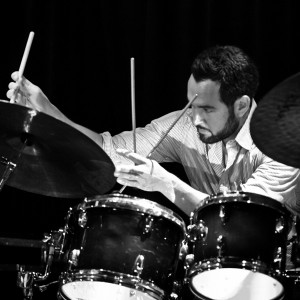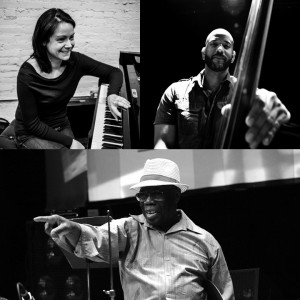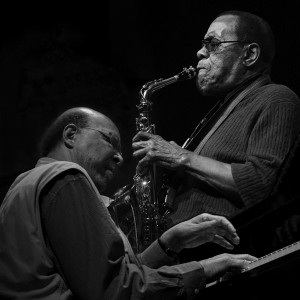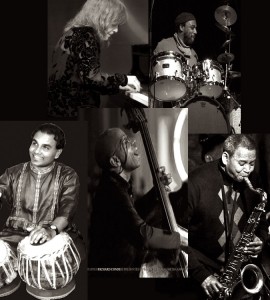 Date: June 15, 2013
Date: June 15, 2013
Venue: the Roulette (NY)
Review by Matt Cole – All photos courtesy of the Vision Festival
The Vision Festival is perhaps the most prominent and important ongoing festival of avant-garde and free music. This year, it took place over five days at the 2-year old Brooklyn home of the long-standing art and performance space, Roulette. With panels, and performances by many prominent masters of free music, it is a must-attend for aficionados of radical spontaneous composition.
Free music can be very tricky to make. Creating coherent spontaneous music in groups requires the musicians to be very present, engaged, and undistracted; without a strong connection between performers, the result can be disjointed and sterile. At last year’s Vision Festival, on the night I went, some of the performances came off a little cold, despite the obvious skills of each of the individual performers. This year, happily, I felt more of an emotional connection with each of the ensembles.
 I arrived just after the first band of the evening, Tomas Fujiwara & the Hookup, had begun their set. Trumpet player Jonathan Finlayson was laying down a rapid fire solo over Mary Halvorson‘s angular guitar accompaniment, while Fujiwara provided an active rolling bottom with his drums. Immediately, I noticed a very strong connection between Fujiwara and bassist Michael Formanek. The band then jumped together into what I think was the head, or a head (having missed the first few minutes), which had the feel of a lurching mecha from a dystopian, cyberpunk anime. After this, tenor sax man Brian Settles took a very free solo, initially over drums, before the rest of the rhythm section came in to provide a stormy backdrop. Settles, and the band behind him, built his solo patiently and well; the band did this consistently over the course of the set. All of a sudden, the band slowed on a dime, and ended with a lyrical and spacious feel.
I arrived just after the first band of the evening, Tomas Fujiwara & the Hookup, had begun their set. Trumpet player Jonathan Finlayson was laying down a rapid fire solo over Mary Halvorson‘s angular guitar accompaniment, while Fujiwara provided an active rolling bottom with his drums. Immediately, I noticed a very strong connection between Fujiwara and bassist Michael Formanek. The band then jumped together into what I think was the head, or a head (having missed the first few minutes), which had the feel of a lurching mecha from a dystopian, cyberpunk anime. After this, tenor sax man Brian Settles took a very free solo, initially over drums, before the rest of the rhythm section came in to provide a stormy backdrop. Settles, and the band behind him, built his solo patiently and well; the band did this consistently over the course of the set. All of a sudden, the band slowed on a dime, and ended with a lyrical and spacious feel.
The next piece showcased Mary Halvorson’s guitar chops. It began with angular interplay between her guitar and the horns, and then she came to the forefront. At times, her guitar sounded like a prepared piano, at others, she bent notes and created fluid sounds like an electric sitar. There were even hints of rockabilly, and as the drums switched from pulsating comping to funky beats, Halvorson’s playing brushed the edges of psychedelia. It must be stressed that for all the pyrotechnics and interesting sounds, Halvorson wasn’t showing off; rather, her advanced technique was made an essential component of the music being created. After the horns added some soulful lines, Finlayson took the lead, evoking the feeling of turbulence that comes with times of change; I felt the turmoil and troubles of both the ’60s and today in his playing.
The rest of the set similarly featured the individual musicians showcasing their outstanding and varied techniques, and using their skills and communication to create compelling music on the fly. Fujiwara provided a very solid bottom with his interesting, oblong rhythms.Formanek switched back and forth easily from combining with Fujiwara to form a solid rhythm section, to interacting with the other tonal players, who did a fine job shifting in and out of lead and support roles.
 Up next was a trio consisting of Kris Davis on piano, Eric Revis on bass, and Andrew Cyrille on drums. They proceeded to create a new, 3-movement piece on the spot. The music started in waves, with one musician playing, then the next, and so forth. Soon, they began to overlap, and then all play together; again with excellent communication between band members, which makes for a good connection with the listening audience. Pianist Davis produced a wide range of sounds from her instrument, from rapid arpeggios to lyrical lines, to hypnotic repeating chords, using the whole piano while often sounding stormy and yet optimistic at the same time. At times, she let her left hand take the lead while her right hand played rhythm, at other times there was conversation between her two hands as if they were separate players. Drummer Cyrille added stormy and propulsive rhythms, often pulling off the neat trick of sounding very free while locking into a nice groove; these grooves would keep an overall shape (sometimes changing over time) that shifted in the details if one listened closely. Bassist Revis occupied well several different spaces over time, sometimes taking the lead, and demonstrated outstanding and sensitive use of volume. At one point he took an arco solo, but with the bow reversed so that the wooden part was rubbing the strings; this created a very tasty subtonal rumble.
Up next was a trio consisting of Kris Davis on piano, Eric Revis on bass, and Andrew Cyrille on drums. They proceeded to create a new, 3-movement piece on the spot. The music started in waves, with one musician playing, then the next, and so forth. Soon, they began to overlap, and then all play together; again with excellent communication between band members, which makes for a good connection with the listening audience. Pianist Davis produced a wide range of sounds from her instrument, from rapid arpeggios to lyrical lines, to hypnotic repeating chords, using the whole piano while often sounding stormy and yet optimistic at the same time. At times, she let her left hand take the lead while her right hand played rhythm, at other times there was conversation between her two hands as if they were separate players. Drummer Cyrille added stormy and propulsive rhythms, often pulling off the neat trick of sounding very free while locking into a nice groove; these grooves would keep an overall shape (sometimes changing over time) that shifted in the details if one listened closely. Bassist Revis occupied well several different spaces over time, sometimes taking the lead, and demonstrated outstanding and sensitive use of volume. At one point he took an arco solo, but with the bow reversed so that the wooden part was rubbing the strings; this created a very tasty subtonal rumble.
Like the band before them, this trio was very tight; the 3rd movement provided a perfect example of this: the music started off very ethereal, with lots of space, and Cyrille making unusual noises by blowing and clicking on his snare. The music built subtly, so all of a sudden (but without a nonsensical break) things were active and stormy, before the band stopped on a musical dime and came down with a gentle, ethereal ending.
 Third up was a duo consisting of avant-garde vets Sonny Simmons on alto and Dave Burrell on piano. Their set opened up with Simmons playing what could be described as John Coltrane doing music for a ’40s noir detective movie. A few times, his playing reminded me of Ornette Coleman’s soundtrack to Naked Lunch, but with just a hint of jump blues. As Burrell came in, I noticed that like the other performers on this night, there was very good communication between the instrumentalists; in this case, manifested by some intense call and response between the two. Often, the musical sounded very lyrical and bluesy, while still being free, with very good use of chordal extensions. Simmons used altissimo to great effect, with very expressive high notes. Burrell showed a lot of range in his playing, at times sounding like avant-garde 20th-century classical music, and at other times, very jazzy with a stride feel (but definitely far out). Like the other ensembles on this night, there was logical progression to the music; and a good range of feel and emotion; at times, this duo felt rainy, and at other times, sunny.
Third up was a duo consisting of avant-garde vets Sonny Simmons on alto and Dave Burrell on piano. Their set opened up with Simmons playing what could be described as John Coltrane doing music for a ’40s noir detective movie. A few times, his playing reminded me of Ornette Coleman’s soundtrack to Naked Lunch, but with just a hint of jump blues. As Burrell came in, I noticed that like the other performers on this night, there was very good communication between the instrumentalists; in this case, manifested by some intense call and response between the two. Often, the musical sounded very lyrical and bluesy, while still being free, with very good use of chordal extensions. Simmons used altissimo to great effect, with very expressive high notes. Burrell showed a lot of range in his playing, at times sounding like avant-garde 20th-century classical music, and at other times, very jazzy with a stride feel (but definitely far out). Like the other ensembles on this night, there was logical progression to the music; and a good range of feel and emotion; at times, this duo felt rainy, and at other times, sunny.
 The final act of the night was Reggie Workman’s WORKz. Workman, of course, has quite an impressive c.v. (most notably playing with John Coltrane and Art Blakey), and tonight was joined by Marilyn Crispell on piano, Odean Pope on tenor, Tapan Modak on tablas, and Pheeroan akLaff on drums. The set opened with only Crispell and Workman on stage for a prayer; Workman came in first, and when Crispell joined, played a lovely arco lead, optimistic and uplifting with much use of overtones. After this, they were joined onstage by the rest of the band. Individually, all of the players delivered fine performances. Pope used an array of extended techniques in his playing, with multiphonic altissimo shouts, and yet also managed to be bluesy at times, also delivering some lines which would have fit right in with a ’60s hard bop or modal ensemble; and toward the end he even brushed up into gospel territory. Best of all, he managed to mix these techniques very well, creating a whole that was more than the sum of its considerable parts. Modak added much to the ensemble with his 5 tablas, using their different tones and capabilities like a miniature tabla tarang.Crispell provided rich soundscapes, leaving appropriate space, and when she took the lead, played fast, busy leads. akLaff provided a solid percussive foundation to the ensemble, his active and pulsating rhythms sending his sticks flying a few times. And Workman, of course, held everything together, providing a foundation of lyrical, rhythmic lines, making good use of glissando on occasion, and even playing some didgeridoo at one point. Like the other ensembles of the night, the band meshed well; listening and communicating intently in order to create compelling and interesting music on the spot.
The final act of the night was Reggie Workman’s WORKz. Workman, of course, has quite an impressive c.v. (most notably playing with John Coltrane and Art Blakey), and tonight was joined by Marilyn Crispell on piano, Odean Pope on tenor, Tapan Modak on tablas, and Pheeroan akLaff on drums. The set opened with only Crispell and Workman on stage for a prayer; Workman came in first, and when Crispell joined, played a lovely arco lead, optimistic and uplifting with much use of overtones. After this, they were joined onstage by the rest of the band. Individually, all of the players delivered fine performances. Pope used an array of extended techniques in his playing, with multiphonic altissimo shouts, and yet also managed to be bluesy at times, also delivering some lines which would have fit right in with a ’60s hard bop or modal ensemble; and toward the end he even brushed up into gospel territory. Best of all, he managed to mix these techniques very well, creating a whole that was more than the sum of its considerable parts. Modak added much to the ensemble with his 5 tablas, using their different tones and capabilities like a miniature tabla tarang.Crispell provided rich soundscapes, leaving appropriate space, and when she took the lead, played fast, busy leads. akLaff provided a solid percussive foundation to the ensemble, his active and pulsating rhythms sending his sticks flying a few times. And Workman, of course, held everything together, providing a foundation of lyrical, rhythmic lines, making good use of glissando on occasion, and even playing some didgeridoo at one point. Like the other ensembles of the night, the band meshed well; listening and communicating intently in order to create compelling and interesting music on the spot.
Overall, this night of music was quite enjoyable. I felt an emotional connection with all four bands; all of whom managed to balance individual pyrotechnics and skill with the collaborative spontaneous creation of interesting and engaging music.
Related posts
VISION FESTIVAL 18 Report P.1: feat. Steve Dalachinsky/Connie Crothers Duo and Bern Nix Quartet
Vision Festival 18 Report P.2: The Evening of the Final Day
Vision Festival 18 Report P.3: Milford Graves Lifetime Achievement Award and performances

